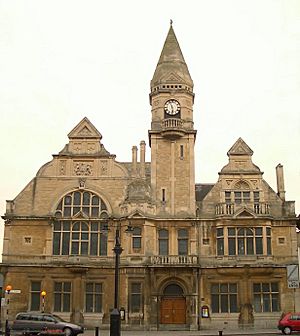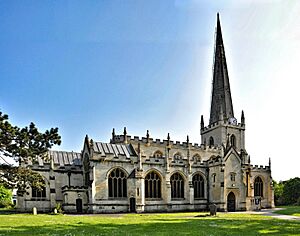Trowbridge facts for kids
Quick facts for kids Trowbridge |
|
|---|---|
| County town | |
 Trowbridge Town Hall, seen from Fore Street |
|
| Population | 37,169 (2021 Census) |
| OS grid reference | ST856579 |
| Unitary authority |
|
| Ceremonial county | |
| Region | |
| Country | England |
| Sovereign state | United Kingdom |
| Post town | TROWBRIDGE |
| Postcode district | BA14 |
| Dialling code | 01225 |
| Police | Wiltshire |
| Fire | Wiltshire |
| Ambulance | Great Western |
| EU Parliament | South West England |
| UK Parliament |
|
Trowbridge is a historic town in Wiltshire, England. It is the main town, or county town, of Wiltshire. Trowbridge is located on the River Biss, close to the border with Somerset. It is about 8 miles (13 km) south-east of Bath. In 2021, about 37,169 people lived in the town.
Trowbridge has been a busy market town for a long time. The Kennet and Avon canal, north of the town, helped Trowbridge grow a lot. The canal allowed coal to be brought from the Somerset Coalfield. This helped the town's woollen cloth mills start using steam power. In the late 1700s and early 1800s, Trowbridge was the most important place for making woollen cloth in south-west England. It was even called "The Manchester of the West" because of its busy factories.
The town area includes smaller places like Longfield, Lower Studley, Upper Studley, Studley Green, and Trowle Common.
Contents
History of Trowbridge
What's in a Name?
The exact meaning of the name Trowbridge is not fully known. One idea is that it comes from "treow-brycg," which means "Tree Bridge." This would refer to the very first bridge built over the River Biss. Another idea suggests the name means "the bridge by Trowle." Trowle is a small village and a common area west of the town. On an old map of Wiltshire from 1611, the name was spelled Trubridge.
Buildings and Design

Trowbridge has many interesting old buildings, especially those connected to its textile past. The Newtown area is a special "conservation area." This means it's protected because it has many beautiful Victorian houses.
The Town Hall is on Market Street. It is a grand building given to the town by a local businessman, Sir William Roger Brown, in 1889. This gift celebrated Queen Victoria's 50 years as queen. The town also has six buildings that are "Grade I listed." This means they are very important historical buildings. These include St James' Church and Lovemead House.
How Trowbridge is Governed
The Town Council is the first level of local government in Trowbridge. It is made up of 21 councillors who help run the town.
County Hall is in Bythesea Road. This building is the main office for Wiltshire Council. This council manages services for the whole county of Wiltshire. Trowbridge is part of the South West Wiltshire area for national government. This area has been represented by Andrew Murrison from the Conservative party since 2010.
Geography of Trowbridge
The River Biss flows into Trowbridge from the south-east. It goes through Biss Meadows, which is a country park. Further north in the town, the Lambrok Stream joins the River Biss. The Biss then continues north to join the River Avon.
North-west of Trowbridge, there's a protected green area called the Avon Green Belt. This area stops the town from expanding too much towards Bradford-on-Avon. While some housing areas near Staverton and Hilperton are connected to Trowbridge, villages like Southwick and North Bradley keep their own separate identities.
Population Changes
The first official count of people in 1801 showed Trowbridge had 5,799 residents. This number grew quickly to 9,545 by 1821. From 1951 to 2011, the population grew by 133%. As more people moved to Trowbridge, many fields and riverside areas were turned into new homes.
In 2011, the census showed that most of Trowbridge's population was White (94.8%). The rest included people from Mixed, Asian, Black, and other ethnic groups. By 2021, the population of the built-up area, which includes nearby parishes, was 43,744.
Getting Around Trowbridge
Trowbridge railway station opened in 1848. Today, trains from Trowbridge connect to places like Bristol, Westbury, and Southampton. You can also take trains to Bath and Chippenham.
Trowbridge is about 18 miles (29 km) from junction 17 of the M4 motorway at Chippenham. The A361 road goes through the town, linking it to Swindon and Barnstaple. The A350 road, which goes north to south, passes near the town. The closest airport is Bristol Airport, about 30 miles (48 km) west.
Schools and Learning
Trowbridge has many Primary schools for younger children. These include Bellefield Primary School, The Grove Primary School, and Newtown Primary School.
For older students, the Secondary schools are the Clarendon Academy, the John of Gaunt School, and St Augustine's Catholic College. These schools also have sixth forms for students aged 16-18. Larkrise School is a special school for children aged 3 to 19.
Wiltshire College has a campus in Trowbridge. It offers many different courses for students after they leave school.
Shopping and Fun
Trowbridge town centre is easy to walk around. The main shopping street is Fore Street. There are also modern shopping centres like The Shires and Castle Place. These places have many different shops.
The Civic Centre, which opened in 2011, is a place for events and shows. It's next to the town's central park. Nearby, there's a leisure area with an Odeon cinema and several restaurants.
The old Trowbridge Town Hall is now used for performances and art shows. It's also a meeting place for community groups. At Wiltshire College, the Arc Theatre is used by students and local groups. There is also a concert hall at Wiltshire Music Centre in nearby Bradford-on-Avon.
Trowbridge is part of the traditional West Country Carnival circuit. There is also an annual folk music event called Trowbridge Festival.
Famous People from Trowbridge
Many interesting people have connections to Trowbridge. Isaac Pitman, who invented the Pitman system of shorthand writing, was born here in 1813. There are several plaques in town to remember him.
Sir William Cook, born in Trowbridge in 1905, helped develop Britain's nuclear bomb in the 1950s. Sir William Roger Brown (1831–1902) owned a mill in Trowbridge. He employed over a thousand people and gave a school, almshouses, and the Trowbridge Town Hall to the town.
David Stratton, a famous film critic, was born in Trowbridge in 1939. He later moved to Australia and became well-known for his film reviews.
Several sports stars are from Trowbridge. These include boxer Nick Blackwell, footballer Nathan Dyer, and athlete Danny Talbot. Daniel Talbot won a gold medal in the 4 × 100 m relay at the 2017 World Athletics Championships. The Oliver Twins, who created the popular "Dizzy" video games, grew up in Trowbridge. A building at the Clarendon Academy is named after them. Tom Gale, a high jumper who competed in the 2020 Tokyo Olympics, also went to school in Trowbridge.
Sports and Fun Activities
Trowbridge has a local football club, Trowbridge Town F.C.. They play their games at Woodmarsh, south of the town.
Trowbridge Cricket Club plays at Trowbridge Cricket Club Ground. This ground is also used by the Wiltshire County team. The town's main cricket team plays in the Wiltshire division of the West of England Premier League.
Trowbridge Rugby Football Club plays in Hilperton, north-east of the town. Trowbridge Sports Centre, located at The Clarendon Academy, has the town's only indoor swimming pool.
Town Partnerships
Trowbridge has special partnerships, called twinning, with four other towns around the world:
- Oujda in Morocco (since 2006)
- Leer in Germany (since 1989)
- Charenton-le-Pont in France (since 1996)
- Elbląg in Poland (since 2000)
Trowbridge was the first town in England to twin with a town in an Arab Muslim country.
See also
In Spanish: Trowbridge para niños





